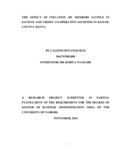| dc.description.abstract | Both changes in inflation rate and savings levels around the globe considerably affects decision making of economic agents (both individuals and institutions) and are arguably considered as major policy variables in macroeconomics. Various factors have influence on saving rate and one of them is inflation. Theoretical and empirical studies have mixed results on the relationship between these two variables and therefore provide a fruitful area for further research for developing countries such as Kenya. This study therefore sought to assess the correlation between these two variables and whether inflation variability has a significant influence and therefore can be a threat to the growth, development and survival of Savings and Credit Cooperative Societies in Kenya. Co-operatives play a major role in resources mobilization, agro-processing and marketing of agricultural produce. The movement plays an important role in wealth creation, food security and generation of employment and therefore alleviating poverty. From the foregoing it is evident that the cooperative movement is of strategic importance in encouraging national savings and development of the country. Changes that occur in the co-operative sector therefore affect the development of the country and the general welfare of the members. The study used a correlation design. Secondary data was drawn from the Kenya National Bureau of Statistics relating to yearly average inflation rates during the period between 2009 and 2013 and from Kenya Union of Savings and Credit Cooperatives (KUSCCO) Kisumu County, relating to yearly members savings with SACCOs, number of members in SACCOs, dividend payout rate SACCOs apply on savings of members, type of SACCOs (whether informal or formal as regards to source of membership) and age of SACCOs. The number of SACCOs from which data was collected was 47. Analysis was performed using descriptive analysis, correlation analysis, and regression analysis. This was done through SPSS software. The study concluded that there is a negative relationship between inflation and savings levels in SACCOs and that this relationship is insignificant (p>0.05). The results further showed that dividend rate paid out to members on their savings has positive relation with the savings level. The variable however does not significantly affect the savings model as the p-value was 0.288 (P>0.05). Number of members in SACCOs had a positive relation with the savings and indicating that the relationship was highly significant in model with a p-value of (0.000). SACCO type had a positive relation with the savings. It indicated that moving from informal to formal SACCO would increase the saving and vice versa. With a p- value of 0.011, this relationship is significant and affects the saving model. Lastly, age of SACCO had a positive relation with savings as a unit increase in the age of SACCOs would significantly increase the savings with a p-value of less than 0.05 | en_US |

